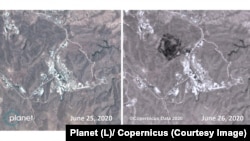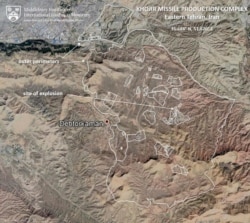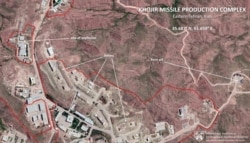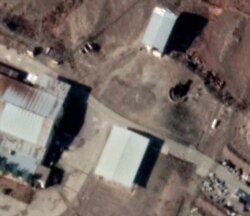On June 25, Tehran residents were treated to an unusual sight, a bright orange light in the nighttime sky over Eastern Tehran. Iranian officials soon claimed that what had happened was a mere explosion of industrial gas tanks in the general area of Parchin, the site of Iran’s vast explosives, rocket, and ammunition manufacturing complex. Yet a closer examination of videos posted on social media seemed to suggest that the blast took place in the Khojir region of Tehran, something finally confirmed by satellite pictures a day later.
While Parchin has gained notoriety for its role in Iran’s pre-2003 nuclear weapons program, Khojir has generally escaped public scrutiny despite being the single most important site associated with Iran’s ballistic missile program. The vast area nestled in between the mountains of East Tehran houses various entities of the Aerospace Industries Organization, itself subordinate to Iran’s Ministry of Defense and Armed Forces Logistics (MODAFL).
The two largest of these are the Shahid Bakeri Industrial Group (SBIG) responsible for the production of Iran’s solid-propellant missiles and the Shahid Hemmat Industrial Group (SHIG) producing Iran’s liquid-fuel ballistic missiles. Both groups, in turn, entail a myriad of sub-companies in Khojir as well as other parts of the country dedicated to the various tasks of missile production.
This institutional setup is reflected in the facilities present at Khojir. Satellite pictures show areas associated with the production of solid-propellant and liquid propellant as well as test stands for liquid propellant engines and solid-propellant rocket motors. Khojir also houses a number of underground facilities whose exact purpose remains unclear.
So how exactly does the explosion fit into this picture? Satellite images and a short video released by Iranian TV show the exact location of the blast at a small facility consisting of two buildings and two roofed support structures within its own security perimeter. The exact purpose of this facility is unclear, however large numbers of discarded blue industrial plastic drums visible in satellite pictures indicate some sort of chemical production or treatment taking place in the area.
The facility adjacent to the site of the explosion shows all the telltale signatures of solid-propellant production, like earthen berms to shield buildings against accidental explosions, buildings of odd shapes and geometry housing chemical production equipment and a pit to burn hazardous fuel residue. Thus, it seems likely that the site of the explosion is functionally related to one of SBIG’s solid propellant production sites. While higher-resolution imagery of the site has yet to be released, it seems that damage to the overall facility is relatively limited.
Right at the epicenter of the explosion, there are two roofed structures similar to the destroyed one seen in Iranian TV footage of the site. Storage tanks as well as a parked tanker truck are visible in historical satellite imagery of both structures. Thus, an explosion of a liquid or gas storage site seems like the most likely explanation. While this corroborates Iranian statements to some degree, it remains unknown exactly what gas or liquid was stored there and contrary to Iranian statements, the storage area was indeed related to a military site.
It is not clear why Iranian officials decided to name Parchin as the site of the explosion instead of the actual site located almost 20km away from the Parchin complex. One reason could be a reluctance to talk about the complex for reasons of operational secrecy. While Parchin has been officially mentioned in Iranian media and was the subject of a highly publicized visit by Iran’s Supreme Leader in 1998, Iranian officials have barely acknowledged Khojir.
As is the case with many spectacular explosions in the Middle East, the question of whether the incident in Khojir was caused by an accident or sabotage is high on everybody’s mind. Unfortunately, it is also extremely difficult to answer. Iran has a history of foreign sabotage against its sensitive installations, ranging from cyber attacks on its nuclear facilities to the injection of faulty components into its missile supply chain.
Yet, Iran also has a history of military accidents with the shootdown of Ukraine flight 752 and the accidental targeting of the Konarak vessel being only the most recent examples. How Iran’s disastrous financial situation has affected routine maintenance and safety precautions is up to anyone’s guess. The 2011 explosion in Bidganeh offers a cautionary tale in how difficult it can be to establish the cause of an explosion.
Much more devastating than this week's incident in Khojir, the blast wiped out Iran’s solid-propellant development site in Bidganeh and killed the father of Iran’s missile program, Hassan Tehrani Moghaddam and dozens of his coworkers. Yet, almost a decade after its occurrence, it still has not been established whether the explosion was an accident or sabotage, with Iranian officials themselves sending mixed signals. Therefore, like so many incidents involving Iran’s military infrastructure, the real cause of the Khojir explosion might never become known.










